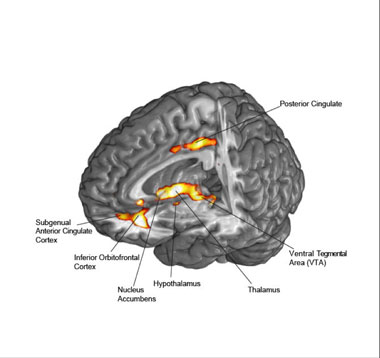 Obesity gene linked to ‘hunger hormone’
Obesity gene linked to ‘hunger hormone’
Obesity is becoming an ever-larger problem. One in four adults in the UK are clinically obese (BMI < 30kg/m2). Estimates predict that by 2050 this figure will rise to 60% in men, 50% in women and 25% in children (Foresight 2007). So what’s causing us to pile on the pounds? While there is much investigation into the effects of diet and lifestyle, scientists are also hot on the trail of risk genes for obesity.
New research from the CSC’s Metabolic Signalling Group and collaborators from UCL and King’s College London, helps explain how the biggest known genetic risk for obesity works. Group Leader, Dominic Withers sums up, “we found that variations in the FTO gene affect circulating levels of ‘hunger hormone’ ghrelin.” Normally ghrelin levels are high before a meal, and fall off afterwards. “But for one in six people, who carry two copies of the obesity risk gene, ghrelin doesn’t drop off after eating,” clarifies Withers. So they soon start to feel hungry again.
“FTO is the strongest obesity risk gene that there is,” says Withers. Previous, genome-wide association studies (GWAS) have shown that people with SNPs (Single Nucleotide Polymorphisms) within the first intron (non-coding region) of the FTO gene have a higher BMI and more fat tissue than those without the genetic variation.
Dr Rachel Batterham, senior author of the study published in the Journal of Clinical Investigation, compared a group of ten high-risk males (carrying two copies of the FTO risk variant) with ten low-risk males (homozygous for normal FTO). She measured their ghrelin levels and asked them to rate their hunger before and after a standard meal. The high-risk group felt hungrier, and had higher ghrelin levels, after eating than the control group.
fMRI scans allowed the research team to investigate the brain’s response to images of high and low-calorie foods. The VTA (Ventral Tegmental Area) responsible for appetite control responded differently in study participants homozygous for the FTO mutation. As Batterham notes, “We’ve known for a while that variations in the FTO gene are strongly linked with obesity, but until now we didn’t know why. What this study shows us is that individuals with two copies of the obesity-risk FTO variant are biologically programmed to eat more. Not only do these people have higher ghrelin levels and therefore feel hungrier, their brains respond differently to ghrelin and to pictures of food – it’s a double hit.”

The researchers also investigated the situation at the molecular level. Boosting the expression of FTO in mouse cells effectively bumped up the production of ghrelin. When they compared this to human cells from the high-risk group they found levels of FTO expression were significantly higher, and correspondingly more ghrelin mRNA was found, than in cells from the low-risk group.
The FTO gene itself encodes a protein enzyme, which changes the methylation status of ghrelin mRNA. As Withers goes on to clarify, “increased FTO mRNA lowered methylation levels on ghrelin mRNA, which raised production of the protein itself. We know methylation on DNA can regulate genes, but we’re just starting to uncover how similar biochemical modifications on mRNA can affect protein manufacture. FTO was a surprising candidate for an obesity risk gene but the new molecular understanding of its targets will help determine how variations in the gene predispose to weight gain”.
The study uncovers a novel mechanism for manipulating ghrelin levels whether by drug or behavioural means. As Batterham notes, “there are some drugs in the pipeline that suppress ghrelin, which might be particularly effective if they are targeted to patients with the obesity-risk variant of the FTO gene.”
MT/BM
Reference: Karra et al, ‘A link between FTO, ghrelin and impaired brain food-cue responsivity’. Journal of Clinical Investigation, 2013
This research has been covered by New Scientist, Science, BBC, Daily Mail and the Telegraph
